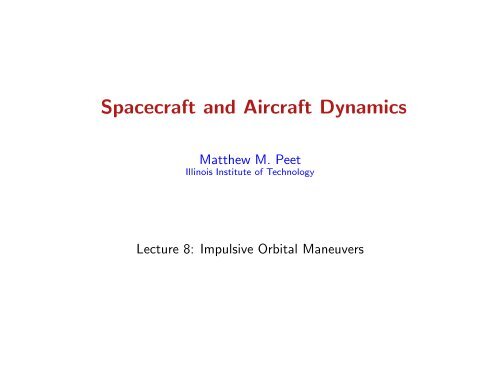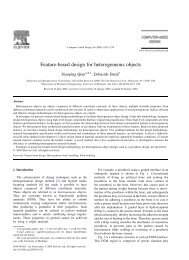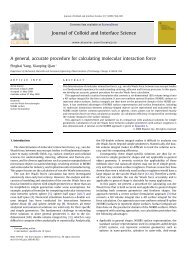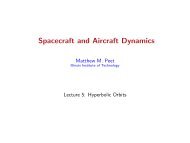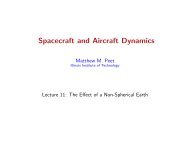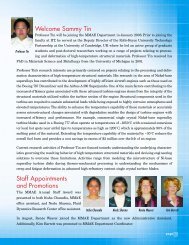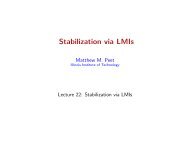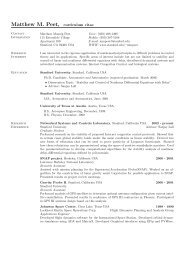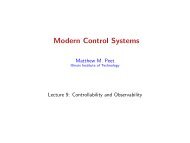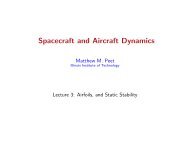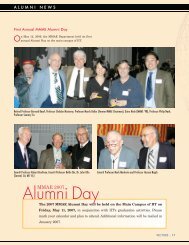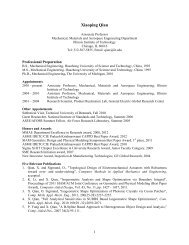Lecture 8: Impulsive Orbital Maneuvers - Illinois Institute of Technology
Lecture 8: Impulsive Orbital Maneuvers - Illinois Institute of Technology
Lecture 8: Impulsive Orbital Maneuvers - Illinois Institute of Technology
Create successful ePaper yourself
Turn your PDF publications into a flip-book with our unique Google optimized e-Paper software.
Spacecraft and Aircraft Dynamics<br />
Matthew M. Peet<br />
<strong>Illinois</strong> <strong>Institute</strong> <strong>of</strong> <strong>Technology</strong><br />
<strong>Lecture</strong> 8: <strong>Impulsive</strong> <strong>Orbital</strong> <strong>Maneuvers</strong>
Introduction<br />
In this <strong>Lecture</strong>, you will learn:<br />
Coplanar <strong>Orbital</strong> <strong>Maneuvers</strong><br />
• <strong>Impulsive</strong> <strong>Maneuvers</strong><br />
◮ ∆v<br />
• Single Burn <strong>Maneuvers</strong><br />
• Hohmann transfers<br />
◮ Elliptic<br />
◮ Circular<br />
Numerical Problem: Suppose we are in a circular parking orbit at an altitude<br />
<strong>of</strong> 191.34km and we want to raise our altitude to 35,781km. Describe the<br />
required orbital maneuvers (time and ∆v).<br />
M. Peet <strong>Lecture</strong> 8: Spacecraft Dynamics 2 / 24
Changing Orbits<br />
Suppose we have designed our ideal orbit.<br />
• We have chosen a, e, i, Ω, ω<br />
• For now, we don’t care about f<br />
◮ Lambert’s Problem<br />
• Don’t care about efficiency<br />
Question:<br />
• Given an object with position, r and velocity v.<br />
• How to move the object into a desired orbit?<br />
Unchanged, the object will remain in initial orbit indefinitely.<br />
M. Peet <strong>Lecture</strong> 8: Spacecraft Dynamics 3 / 24
<strong>Impulsive</strong> Orbit <strong>Maneuvers</strong><br />
Orbit maneuvers are made through changes in velocity.<br />
• r and v determine orbital elements.<br />
• For fixed r, changes in v map to changes in orbital elements.<br />
◮ Set <strong>of</strong> achievable orbits is limited.<br />
◮ Only 3 degrees <strong>of</strong> freedom.<br />
◮ Orbit must pass through r.<br />
M. Peet <strong>Lecture</strong> 8: Spacecraft Dynamics 4 / 24
<strong>Impulsive</strong> Orbit <strong>Maneuvers</strong><br />
The change in position is<br />
• For fixed ∆v, if m<br />
F<br />
• We will assume ∆r = 0<br />
Velocity change is caused by thrust.<br />
• For constant thrust, F,<br />
v(t) = v(0)+ F<br />
m ∆t<br />
• for a desired ∆v, the time needed is<br />
∆r(t) = m∆v2<br />
F<br />
is small, the ∆r is small<br />
∆t = m∆v<br />
F<br />
M. Peet <strong>Lecture</strong> 8: Spacecraft Dynamics 5 / 24
The ∆v Maneuver<br />
∆v refers to the difference between the initial and final velocity vectors.<br />
A ∆v maneuver can:<br />
• Raise/lower the apogee/perigee<br />
• A change in inclination<br />
• Escape<br />
• Reduction/Increase in period<br />
• Change in RAAN<br />
• Begin a 2+ maneuver sequence <strong>of</strong><br />
burns.<br />
◮ Creates a Transfer Orbit.<br />
We’ll start by talking about coplanar maneuvers.<br />
M. Peet <strong>Lecture</strong> 8: Spacecraft Dynamics 6 / 24
Single Burn Coplanar <strong>Maneuvers</strong><br />
Definition 1.<br />
Coplanar <strong>Maneuvers</strong> are those which do not alter i or Ω.<br />
Example: Simple Tangential Burn<br />
• For maximim efficiency, a burn must occur at 0 ◦ flight path angle<br />
◮ ˙r = 0<br />
• Tangential burns can occur at perigee and apogee<br />
M. Peet <strong>Lecture</strong> 8: Spacecraft Dynamics 7 / 24
Example: Parking Orbits<br />
Suppose we launch from the surface <strong>of</strong> the earth.<br />
• This creates an initial elliptic orbit which will re-enter.<br />
• To circularize the orbit, we plan on using a burn at apogee.<br />
Problem: We are given a and e <strong>of</strong> the initial elliptic orbit. Calculate the ∆v<br />
required at apogee to circularize the orbit.<br />
M. Peet <strong>Lecture</strong> 8: Spacecraft Dynamics 8 / 24
Example: Parking Orbits<br />
Solution: At apogee, we have that<br />
ra = a(1+e)<br />
From the vis-viva equation, we can calculate the velocity at apogee.<br />
<br />
2<br />
va = µ − 1<br />
<br />
µ 1−e<br />
=<br />
a a (1+e)<br />
ra<br />
However, for a circular orbit at the same point, we calculate from vis-viva<br />
<br />
µ µ<br />
vc = =<br />
a(1+e)<br />
Therefore, the ∆v required to circularize the orbit is<br />
<br />
µ<br />
∆v = vc −va =<br />
a(1+e) −<br />
<br />
µ 1−e<br />
=<br />
a (1+e)<br />
ra<br />
µ √ <br />
1− 1−e<br />
a(1+e)<br />
• It is unusual to launch directly into the desired orbit.<br />
• Instead we use the parking orbit while waiting for more complicated orbital<br />
maneuvers.<br />
M. Peet <strong>Lecture</strong> 8: Spacecraft Dynamics 9 / 24
Coplanar Two-Impulse Orbit Transfers<br />
Most orbits cannot be achieved using a single burn.<br />
Definition 2.<br />
• The Initial Orbit is the orbit we want to leave.<br />
• The Target Orbit is the orbit we want to achieve.<br />
• The Transfer Orbit is an orbit which intersects both the initial orbit and<br />
target orbit.<br />
Step 1: Design a transfer orbit (a,e,i, etc.).<br />
Step 2: Calculate vtr,1 at the point <strong>of</strong><br />
intersection with initial orbit.<br />
Step 3: Calculate initial burn to maneuver into<br />
transfer orbit.<br />
∆v1 =vtr,1 −vinit<br />
M. Peet <strong>Lecture</strong> 8: Spacecraft Dynamics 10 / 24
Coplanar Two-Impulse Orbit Transfers<br />
Step 4: Calculate vtr,2 at the point <strong>of</strong> intersection with target orbit.<br />
Step 5: Calculate velocity <strong>of</strong> the target orbit, vfin, at the point <strong>of</strong> intersection<br />
with transfer orbit.<br />
Step 6: Calculate the final burn to maneuver into target orbit.<br />
∆v2 =vfin −vtr,2<br />
M. Peet <strong>Lecture</strong> 8: Spacecraft Dynamics 11 / 24
Transfer Orbits<br />
There are many orbits which intersect both the initial and target orbits.<br />
However, there are some constraints.<br />
Consider<br />
• Circular initial orbit <strong>of</strong> radius r2<br />
• Circular target orbit <strong>of</strong> radius r1<br />
Obviously, the transfer orbit must satisfy<br />
and<br />
rp = p<br />
≤ r1<br />
1+e<br />
ra = p<br />
≥ r2<br />
1−e<br />
M. Peet <strong>Lecture</strong> 8: Spacecraft Dynamics 12 / 24
Transfer Orbits in Fixed Time<br />
Lambert’s Problem<br />
Occasionally, we want to arrive at<br />
• A certain point in the target orbit, r2<br />
• at a certain time, tf<br />
Finding the necessary transfer orbit is Lambert’s Problem.<br />
Primary Applications are:<br />
• Targeting<br />
• Rendez-vous<br />
We are skipping the section on<br />
Lambert’s problem.<br />
M. Peet <strong>Lecture</strong> 8: Spacecraft Dynamics 13 / 24
Transfer Costs<br />
The cost <strong>of</strong> a transfer orbit can be calculated using kinetic energy arguments<br />
Ecost = ∆v1 2 +∆v2 2<br />
2<br />
Of course, this doesn’t tell us how good the transfer orbit is.<br />
• The energy difference between 2 orbits must come from somewhere.<br />
∆Emin = − µ<br />
2a2<br />
+ µ<br />
2a1<br />
• The closer Ecost is to Emin, the more efficient the transfer<br />
• More on this effect later<br />
M. Peet <strong>Lecture</strong> 8: Spacecraft Dynamics 14 / 24
The Hohmann Transfer<br />
The Hohmann transfer is the energy-optimal two burn maneuver between any<br />
two coaxial elliptic orbits.<br />
• Proposed by Hohmann (1925)<br />
◮ Why?<br />
• Proven for circular orbits by Lawden (1952)<br />
• Proven for coaxial ellipses by Thompson (1986)<br />
M. Peet <strong>Lecture</strong> 8: Spacecraft Dynamics 15 / 24
The Hohmann Transfer<br />
We will first consider the circular case.<br />
Theorem 3 (The Hohmann Conjecture).<br />
The energy-optimal transfer orbit between two circular orbits <strong>of</strong> radii r1 and r2<br />
is an elliptic orbit with<br />
rp = r1 and ra = r2<br />
This yields the orbital elements <strong>of</strong> the transfer orbit (a, e) as<br />
a = r1 +r2<br />
2<br />
and e = 1− rp<br />
a = r2 −r1<br />
r2 +r1<br />
M. Peet <strong>Lecture</strong> 8: Spacecraft Dynamics 16 / 24
The Hohmann Transfer<br />
To calculate the required ∆v1 and ∆v2, the initial velocity is the velocity <strong>of</strong> a<br />
circular orbit <strong>of</strong> radius r1 <br />
µ<br />
vinit =<br />
The required initial velocity is that <strong>of</strong> the transfer orbit at perigee. From the<br />
vis-viva equation,<br />
<br />
2µ<br />
vtrans,p = −<br />
r1<br />
µ<br />
a = <br />
1 1 r2<br />
2µ − = 2µ<br />
r1 r1 +r2 r1(r1 +r2)<br />
So the initial ∆v1 is<br />
∆v1 = vtrans,p −vinit =<br />
r1<br />
<br />
r2<br />
2µ<br />
r1(r1 +r2) −<br />
<br />
µ µ 2r2<br />
=<br />
(r1 +r2) −1<br />
<br />
The velocity <strong>of</strong> the transfer orbit at apogee is<br />
<br />
2µ<br />
vtrans,a = − µ<br />
a =<br />
<br />
r1<br />
2µ<br />
r2(r1 +r2)<br />
r2<br />
M. Peet <strong>Lecture</strong> 8: Spacecraft Dynamics 17 / 24<br />
r1<br />
r1
The Hohmann Transfer<br />
The required velocity for a circular orbit at apogee is<br />
<br />
µ<br />
vfin =<br />
So the final ∆v2 is<br />
∆v2 = vfin −vtrans,a =<br />
r2<br />
r2<br />
<br />
µ r1<br />
− 2µ<br />
r2(r1 +r2) =<br />
<br />
µ 2r1<br />
1−<br />
(r1 +r2)<br />
Thus we conclude to raise a circular orbit from radius r1 to radius r2, we use<br />
<br />
µ 2r2<br />
∆v1 =<br />
r1 (r1 +r2) −1<br />
<br />
<br />
µ 2r1<br />
∆v2 = 1−<br />
(r1 +r2)<br />
r2<br />
M. Peet <strong>Lecture</strong> 8: Spacecraft Dynamics 18 / 24<br />
r2
Hohmann Transfer Illustration<br />
M. Peet <strong>Lecture</strong> 8: Spacecraft Dynamics 19 / 24
The Hohmann Transfer<br />
Transfer Time<br />
The Hohmann transfer is optimal<br />
• Only for impulsive transfers<br />
◮ Continuous Thrust is not considered<br />
• Only for two impulse transfers<br />
◮ A three impulse transfer can be better<br />
◮ Bi-elliptics are better<br />
The transfer time is simply half the period <strong>of</strong><br />
the orbit. Hence<br />
∆t = τ<br />
<br />
= π<br />
2<br />
a3 <br />
µ<br />
= π<br />
(r1 +r2) 3<br />
2µ<br />
The Hohmann transfer is also the Maximum Time 2-impulse Transfer.<br />
• Always a trade<strong>of</strong>f between time and efficiency<br />
• Bielliptic Transfers extend this trade<strong>of</strong>f.<br />
M. Peet <strong>Lecture</strong> 8: Spacecraft Dynamics 20 / 24
Numerical Example<br />
Problem: Suppose we are in a circular parking orbit at an altitude <strong>of</strong> 191.34km<br />
and we want to raise our altitude to 35,781km. Describe the required orbital<br />
maneuvers (time and ∆v).<br />
Solution: We will use a Hohmann transfer between circular orbits <strong>of</strong><br />
r1 = 191.35km+1ER= 1.03ER and r2 = 35781km+1ER= 6.61ER<br />
The initial velocity is<br />
<br />
µ<br />
vi = = .985 ER<br />
TU<br />
r1<br />
The transfer ellipse has a = r1+r2<br />
2 = 3.82ER. The velocity at perigee is<br />
<br />
2µ<br />
vtrans,1 = − µ<br />
= 1.296ER<br />
a TU<br />
Thus the initial ∆v is ∆v1 = 1.296−.985 = .315 ER<br />
TU .<br />
r1<br />
M. Peet <strong>Lecture</strong> 8: Spacecraft Dynamics 21 / 24
Numerical Example<br />
The velocity at apogee is<br />
<br />
2µ<br />
vtrans,1 = − µ<br />
= .202ER<br />
a TU<br />
r2<br />
However, the required velocity for a circular<br />
orbit at radius r2 is<br />
<br />
µ<br />
vf = = .389<br />
r2<br />
ER<br />
TU<br />
Thus the final ∆v is ∆v2 = .389−.202 = .182ER TU . The second ∆v maneuver<br />
should be made at time<br />
<br />
a<br />
tfin = π<br />
3<br />
µ = 23.45TU = 5.256hr<br />
The total ∆v budget is .497ER/TU.<br />
M. Peet <strong>Lecture</strong> 8: Spacecraft Dynamics 22 / 24
The Elliptic Hohmann Transfer<br />
The Hohmann transfer is also energy optimal for coaxial elliptic orbits.<br />
The only ambiguity is whether to make the initial burn at perigee or apogee.<br />
• Need to check both cases<br />
• Often better to make initial burn at perigee<br />
◮ Due to Oberth Effect<br />
M. Peet <strong>Lecture</strong> 8: Spacecraft Dynamics 23 / 24
Summary<br />
This <strong>Lecture</strong> you have learned:<br />
Coplanar <strong>Orbital</strong> <strong>Maneuvers</strong><br />
• <strong>Impulsive</strong> <strong>Maneuvers</strong><br />
◮ ∆v<br />
• Single Burn <strong>Maneuvers</strong><br />
• Hohmann transfers<br />
◮ Elliptic<br />
◮ Circular<br />
Next <strong>Lecture</strong>: Oberth Effect, Bi-elliptics, Out-<strong>of</strong>-plane maneuvers.<br />
M. Peet <strong>Lecture</strong> 8: Spacecraft Dynamics 24 / 24


